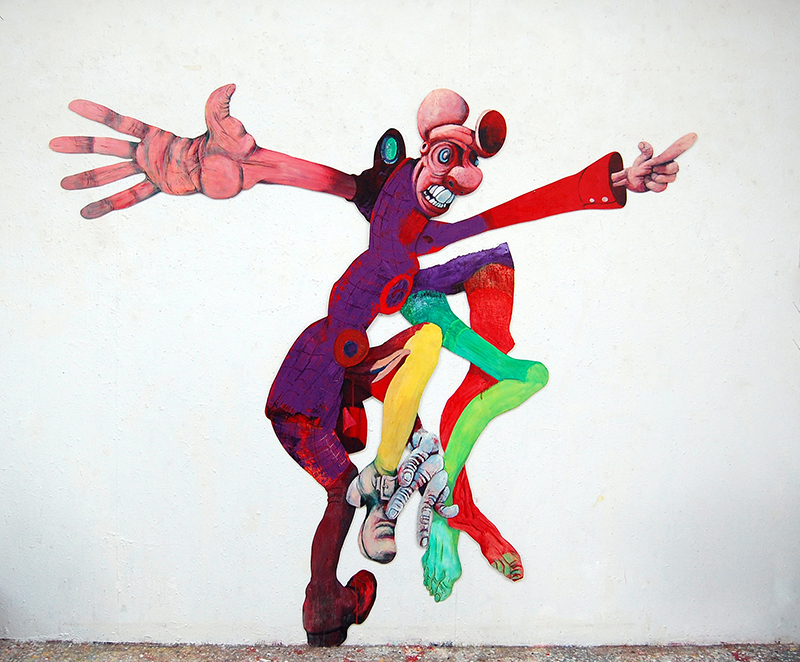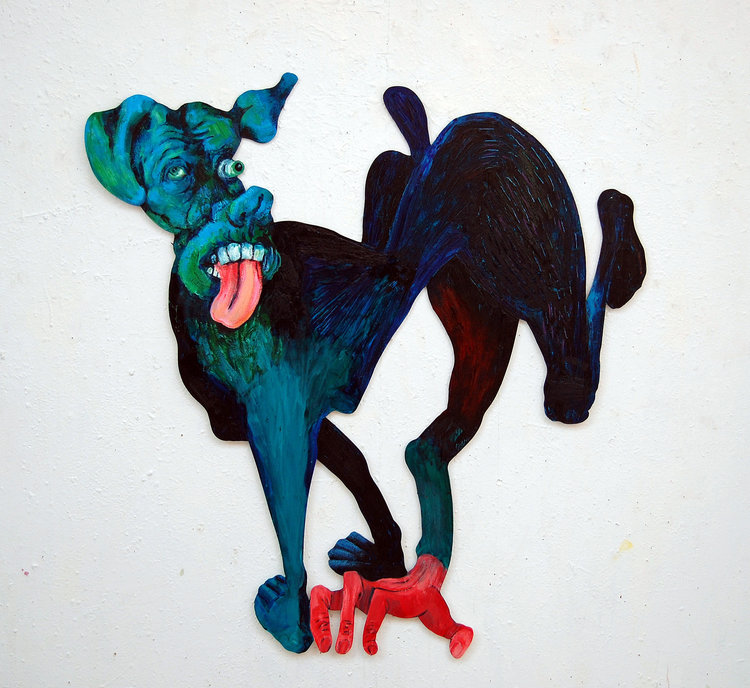Rob McLeod - Beyond Fashion

'Colourful' doesn't even begin to do
justice to Rob McLeod's oeuvre. While his garish,
sclerotic aesthetic owes much to the sixties'
countercultural propensity to shock and awe, above all
there's a resilient strain of humor that has remained
undimmed since he arrived in Wellington forty-five years
ago. McLeod grew up in Glasgow and (as he admitted in a
Dominion Post interview) has never forgotten his home team
Partick Thistle, the perpetual underdog with stamina and
staying-power - "They might not win the cup, but they are
there for playing the game and doing the work. They're there
every week. They might lose, but they're back next
week."
A prolific and vigorous painter, Mcleod has enjoyed solo exhibitions at Pataka Museum of Art and Cultures, Wellington's City Gallery, Paulnache and Bath Street Galleries in Auckland, the Beatty Gallery in Sydney, Campbell Grant Gallery in Christchurch, the Dunedin Public Art Gallery, and the Ashburton Art Gallery. He has also participated in group exhibitions at Adam Art Gallery, Victoria University, the Manawatu Art Gallery in Palmerston North, and a Touring Exhibition for the Wallace Art Award. Examples of McLeod's work can be found in the public collections of Victoria University, Te Papa, Pataka, the Dowse, the Auckland Art Gallery, the Sarjeant Gallery, the Robert McDougall Gallery, and the James Wallace Collection. Last year, he won the prestigious Molly Morpeth Canaday Award from Craig Investment Partners.

Although McLeod has never stopped
painting, for thirty-four years much of his energy also went
into his day job - teaching art at Wellington High School.
Former students include artist Michael Cubey, director and
actor Danny Mulheron, and Shihad frontman Jon Toogood. "I've
never allowed teaching to get in the way of painting, but
then I had a full-time job and four kids," says McLeod. "I
would never rely on painting as a living. It is not regular
money. If it becomes regular money, then you are instantly
tied in to making a product. So teaching gave me the freedom
to do as I please - except I had to teach."
After graduating from the Glasgow School of Art in 1969, McLeod arrived in New Zealand inspired by such abstract artists as Willem de Kooning and Alan Davie. While much of his early work derived from Expressionist and Minimalist abstraction, over the past three decades he has focussed on highly distended physical figurations, featuring cartoon-like imagery with a dark-edged theme, comparable in their hallucinatory nature to Robert Crumb, but combined with a kind of punk/science fiction sensibility.

McLeod initially rebelled against the
Glasgow School of Art's traditional training methods, which
included a strict emphasis on developing life-drawing
skills: "For thirty years, I wanted to be an abstract
artist, but when I gave in to the figuration, all that
training suddenly came out of the end of my hand. I thought,
'I actually can draw. This has actually paid off.' And I
hated it at the time. I'm so apologetic to some of those
teachers [I had] when I fought so hard against
it."
Somewhere along the way, McLeod also abandoned painting on canvas and now prefers using hinged sheets of thin plywood to articulate his bizarre images (while also making them literally easier to move around). Teeth and digits especially are expanded and distorted in a manner reminiscent of those medical diagrams of body parts enlarged in proportion to the number of nerve-endings they contain. Another idiosyncrasy is the way he likes first to cut around his outlandish characters, then attach found materials such as old socks, scarves, and strips of checkered tartan, overpainted with dense layers of oil and enamel - all cobbled together into immensely tactile and vivid Frankenstein hybrids.
McLeod's stretched and contorted polychromatic figures share a vibrantly visceral quality not far removed from either Hieronymous Bosch or Salvador Dali. He feels they are part of an ongoing organic process of bringing to life a familiar cast of fantastic characters that frequently recur in his paintings, and admits that some of his earlier works "were quite limited. There was too much Surrealism. They've become more in your face as people. Even in the 90s, when the works were halfway between abstraction and figuration, I thought of them as people. I was once heralded as one of New Zealand's most interesting abstractionists. Not anymore."
Since the mid-80s, McLeod has lived in a two-storey Edwardian house in Mt Victoria, which also contains his home studio. Like Partick Thistle, he has never really considered himself a professional art world insider: "I quite like to be on the fringes. I'm the guy at the party in the corner with a beer in my hand and everybody's dancing and I'm quite happy. And if you stand there long enough at the party, a lot of people come across and talk to you."
Beyond Fashion (which includes 13 new pieces) is on display at Wellington's {Suite} Gallery on Cuba St until Saturday 7/10.
Selected Bibliography
Aaron Lister (ed.), Dandini Comes Clean: Paintings by Robert McLeod, Paulnache Publishing, New Zealand, 2011.
Aaron Lister (ed.), Robert McLeod, Travelling With The Happy Worm, Art New Zealand No 109, 2004, pp.66-69.
An Orange In A Fried Fish Shop: Paintings by Robert McLeod, essay by Aaron Lister, Craig Potton Publishing, 2003.
A Long Way Home: Rob McLeod, catalogue essay by H. Kedgley, Pataka Museum of Art and Cultures, Porirua, 2002.
Think Colour, catalogue essay by J. Mane-Wheoki, Pataka Museum of Art and Cultures, Porirua, 2000.
Allan Smith, Robert McLeod and the Giggler in the Wood (illus), Art New Zealand No 85, 1998, pp.37-41.
The Objects, the Game and the Life: A Survey Show, catalogue essay by M. Scaife, Sarjeant Gallery, Wanganui, New Zealand, 1997.
Warwick Brown, One Hundred New Zealand Paintings, Godwit Publishing, Auckland, 1995.
Allan Smith, Ways to do More and More (illus), Art New Zealand No 56, 1990, pp.70-74.
Susan Foster, Robert McLeod: An Interview, Art New Zealand No 46, 1988, pp.64-67.
Content/Context: A Survey of Recent New Zealand Art, catalogue essay by L. Bieringa, National Art Gallery, New Zealand, 1986.
Elva Bett, New Zealand Art: A Modern Perspective, Reed and Methuen Publishing, Auckland, 1986.
Jim and Mary Barr, Contemporary New Zealand Painters, Alister Taylor Publishing, Martinborough, 1980.
Peter Cape, New Painting since 1960, Collins Publishing, Auckland,1979.



 Tertiary Education Union: UCOL Cuts Will Cause Lasting Damage
Tertiary Education Union: UCOL Cuts Will Cause Lasting Damage National Library Of New Zealand: Kate De Goldi Named Te Awhi Rito Reading Ambassador For Aotearoa
National Library Of New Zealand: Kate De Goldi Named Te Awhi Rito Reading Ambassador For Aotearoa Hikoi for Health: Healthcare Crisis Drives Cross-Country Protest | Hīkoi For Health Set To Begin
Hikoi for Health: Healthcare Crisis Drives Cross-Country Protest | Hīkoi For Health Set To Begin University of Auckland: New Zealand Professor's Paper Is One Of Century's Most-Cited
University of Auckland: New Zealand Professor's Paper Is One Of Century's Most-Cited Taite Music Prize: The 2025 Taite Music Prize Winner Is MOKOTRON - WAEREA
Taite Music Prize: The 2025 Taite Music Prize Winner Is MOKOTRON - WAEREA Health Committee: Have Your Say On The Medicines Amendment Bill
Health Committee: Have Your Say On The Medicines Amendment Bill